About Pedro Antonetty:
Pedro Antonetty of Harrisburg, PA is a Puerto Rican drummer and drum maker. He spoke with folklorist Amy Skillman about commitment to one’s passions and fearless exploration of new musical ground.

photo of Pedro Antonetty by Amy Skillman
About Pedro Antonetty
Roots and routes
Pedro Antonetty grew up in the town of Salinas on the southern coast of Puerto Rico. The mountains that run down the middle of the island break up the storms, making Salinas very dry and very sunny. Salinas also offers some of the best seafood on the island. His father was the cook in the family: “He was dangerous in the kitchen. Nothing went to waste.” The home was surrounded by sugar cane fields, and there was a racetrack nearby — “so the noise of engines revving up and the smell of burnt rubber bring back awesome nostalgia.”
His grandfather worked in the sugar cane fields, cutting cane. As a child, Pedro was often given a machete to go help with the cutting, frequently coming home with blisters. He remembers the fires that were lit at night to prepare the cane for harvest. The next morning, the field would be covered in ash, but it was easier to get to the cane stalks for cutting after the excess flora was burned away.

Images of Salinas, Puerto Rico and sugar cane via Wikimedia Commons — see footnote 1
Musical beginnings
It was July 1979 when his family made the decision to come to the continental United States. They were planning to visit with extended family, but never went back. They landed in Newark, NJ and, by the time Pedro was in elementary school, they moved to Philadelphia where his maternal grandmother lived. There, they became part of a large Puerto Rican community.
Growing up in that community, Pedro was immersed in traditional music. His dad played minor percussion and sang the traditional songs. Pedro especially recalls the parranda — the Puerto Rican form of Christmas caroling. Friends and families would gather in front of a house, usually late in the evening, with instruments such as panderos, maracas, güiros, cuatros, and guitars to sing aguinaldos (traditional Christmas songs). They would sing a song or two; perhaps share some food and drink; and then those who had been serenaded would join the group and they would all go to the next house.
Pedro remembers the growing number of cars as the procession continued through the neighborhood until late at night, sometimes into the morning. Some researchers say the parranda derives from reenactments of the Biblical tradition of Mary and Joseph searching for shelter, but for many, the original significance is lost. “Just showing up at people’s houses to serenade them... that was always a major aspect of our culture.”
“Throughout the years, I never really learned anything as far as playing an instrument. But when I graduated from college, I gave myself a gift: I bought a set of congas and started the journey on my own.”
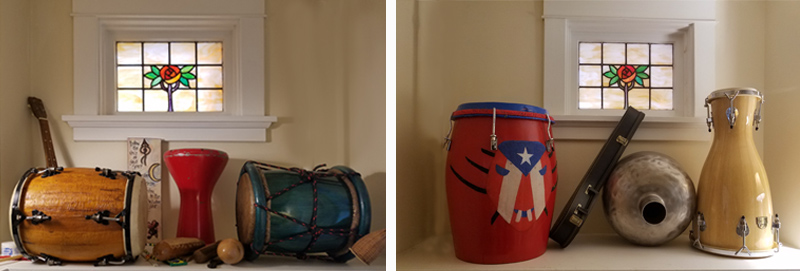
photo by Amy Skillman
Starting the drum journey...
Pedro describes Philadelphia as multi-cultural, multi-ethnic — a feast for the curious. In high school, learning about acoustics in physics class set him on a course of DJ-ing, and he developed a fine-tuned ear for nuances in the music. He had a Middle Eastern friend who got him playing Middle Eastern music. A year after that, a friend at Temple University called him up and said, “Pedro, you gotta get down here, you gotta get down here tonight. Bring $10 and bring one of your drums.” Pedro took his djembe and found himself in a West African master class for students and alumni. That got him involved in West African culture.
Then in 2004, Philly hosted its first Brazilian festival and Olodum, Bahia’s premier Carnaval band, was there. “I couldn’t believe the amazing stuff that I was watching... it was about more than listening to the singer. The main drummers were tossing mallets across the stage, not missing a beat...”
...and circling back around
As he got a little older, he started to appreciate his own culture. “I had done all these classes and explorations into other cultures, and came back full circle at age 40. I thought, ‘I need to make this [turning 40] really special’ and that’s when I started looking into making drums for myself... I wanted to do something for myself from the culture. So I started researching how to make my own bomba drums.”
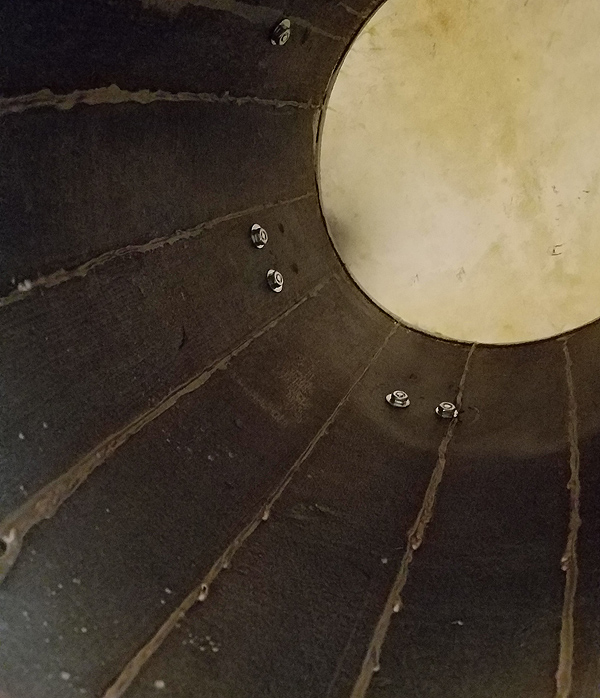
photo by Amy Skillman
What is bomba music?
Bomba music is rooted in the history of African slavery in Puerto Rico, but includes elements borrowed from Taino (indigenous) and Spanish (colonialist) traditions. Today’s Puerto Rican bomba music is an expression of culture and identity. Reflecting on the blisters he got when he worked the machete in the cane field, Pedro says it is hard to understand what the slaves went through. “Music must have been one of the ways to get through. The drumming connected them back home to Africa, brought them together; unified them. To some degree, it set you free. Music literally saved their lives.”
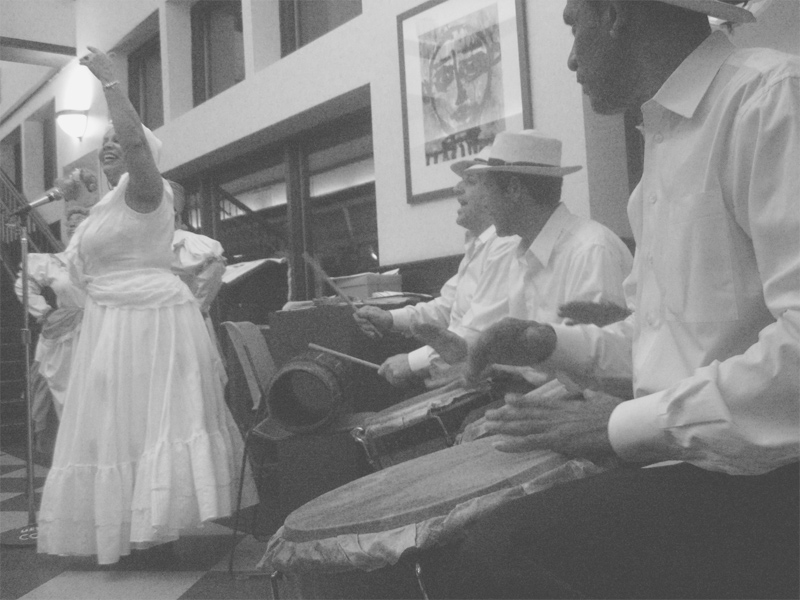
image from Wikimedia Commons — see footnote 2
Today, a bomba band often includes singers, dancers, and several percussion instruments including various sizes of the drum (traditionally made from discarded rum barrels), maracas (shaker), and cuá (two sticks hit on the side of the drum). Only one dancer performs at a time. A powerful synergy develops between the dancer and the primary drummer, who tries to anticipate and reflect the dancer’s moves. It is also playful: part invitation, part duel. Dance movements from the waist down, or moves that bring the body in, correspond with the lower tones on the drum. The “slap” or higher tones of the drum match outward and upper-body movements.
In Puerto Rico, bomba drums are called barriles, which is Spanish for barrel. They are traditionally made from discarded rum barrels.
Pedro and his father heard about a wine-maker in New Jersey who was finished with his wine-making experiments and wanted to get rid of his barrels. They thought that would be a good place to start if he wanted to make his own drum. So they went to pick them up. “Our family is kind of gifted that way, we’re tinkers. I work on my own car, for example... I paint, do construction, you know. I’m not afraid of anything.”
He started by taking the barrels apart, numbering the staves as he did. He put them back together, sanded them down, and painted them, with decorations that connected “me here with Puerto Rico there.” He mixed dyed sand from Puerto Rico with local sand to create the designs. He finished three of those drums for himself. A friend saw them and wanted one, so he started making them for others. Some people have asked to buy those original drums from him, but he refuses. “These are my babies. I have invested a lot of heart and soul into it.”
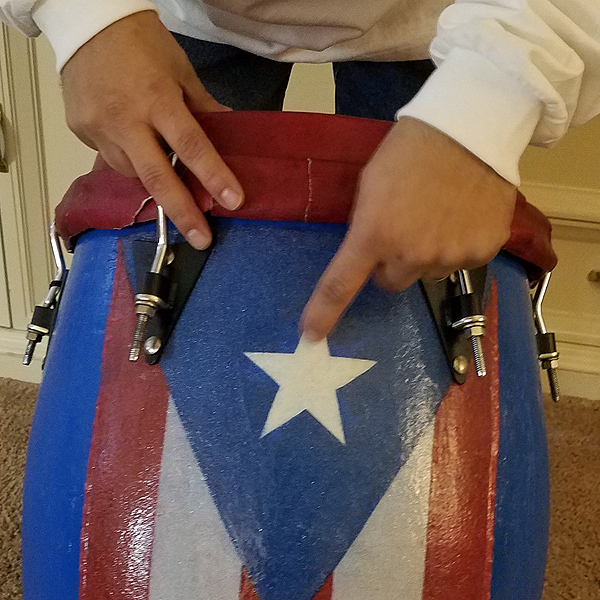
photo by Amy Skillman
When Pedro first started learning about drums, a djembe drummer told him about the three spirits in the drum: the spirit of the tree, the spirit of the skin of the animal used for the head, and the spirit of the master drum maker who put it together. “When you hit this drum; when you tap, and knock at the door, you’re waking up the spirits that live in the drum.” That’s pretty powerful and made him realize that if he sells a drum, he sells it to someone who is committed to the spirit of the drum.
If you are a drummer, Pedro believes, “you should learn how to make a drum so you can appreciate it at a deeper level.”
Pedro hasn’t only made bomba drums. As an avid concert goer, he is intrigued by percussion instruments from all over the world and is constantly finding new instruments to add to his repertoire and collection. After a performance by a Taiko drum group from Japan, Pedro went backstage to find out how he could get one. When he realized how expensive they are, he decided to make one himself.
Pedro works hard to understand the instrument and the music in the context of the community, and to demonstrate respect for the culture when he plays. His drumming and drum-making reflect his lifelong curiosity and interest in history, and his belief that “in life, you are an eternal learner.”
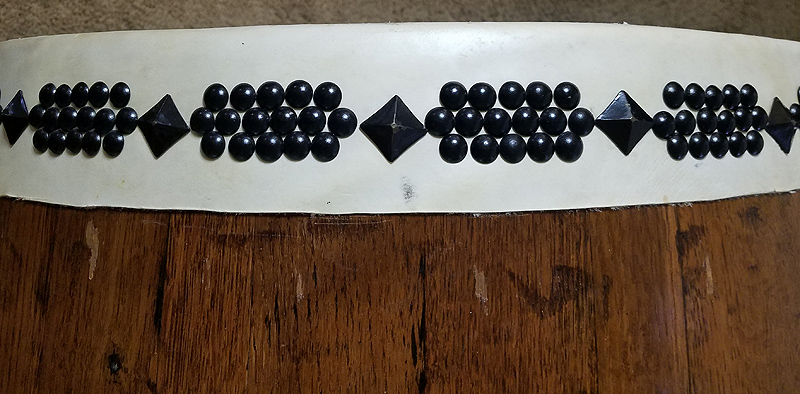
photo by Amy Skillman
Following your passion takes commitment
“If you don’t take the chance to really do it, to try to make it happen, then you’re not really serious about it,” Pedro says. He likens this kind of exploration to being in college. “You make the investment; buy the books and the supplies. Now that you have paid for that, you have to get serious and do it. You have to put the time in.”
“Don’t be afraid to fail. It’s part of the process.”
Pedro believes, “We all should have the mentality to not be afraid to try anything new; and don’t be afraid to fail. It’s part of the process.” Several of his drum-making endeavors appeared to be failures at first, but became something wonderful.
He once made a djembe that was too thick for the sound he intended. After playing it for awhile, and lamenting his mistake, he realized it had the right tone for bomba. “It adds a different flavor. Something cool came out of making a mistake.” Another time, he left a skin for a drum head in water too long, which made the skin thicker than he wanted. When he pulled it out, he was sure he had ruined it, but he went ahead and put it on the intended drum... and discovered that it actually gave the drum more resonance.
One day he discovered a lamp in a thrift store made out of a mini barrel. He grabbed it right away, took it home, took it apart, glued it back together, and turned it into one of the smaller drums in the bomba pantheon of drums.
In the video below, Pedro plays a small drum called a batá, which he made by cutting down a mini-conga and fitting a second drum head on the small end.
New home, new music
Pedro moved to Harrisburg for love. Although the move was worth it, it was a big change: the music scene is smaller with fewer opportunities to play. But it didn’t take long before he was adding Latin rhythms to the sounds of several local musicians. He has discovered Ricky’s Kitchen — a Friday night jam session that introduced him to Brazilian and flamenco musicians — and he sings with a local gospel choir. He has performed with the Duval Street Band and with Los Monstros, and is currently performing with Brazilian Vibes and Canvas.
Although he loves his bomba roots, Pedro embraces opportunities to explore cross-cultural music ideas. He has a philosophy of what he calls “cross-dressing” the instruments — using traditional instruments from one genre in a new context “to give the music of another genre an interesting twist”
“We are our worst critic... we limit ourselves” if we don’t explore what is possible.
Pedro shares the story of a drummer in a Moroccan restaurant who “was killin’ the dumbek.” When Pedro spoke with him afterwards, he learned the drummer was from Caracas, Venezuela and worked at a pizza shop down the street. “That helped me to really understand that music has no barriers.”
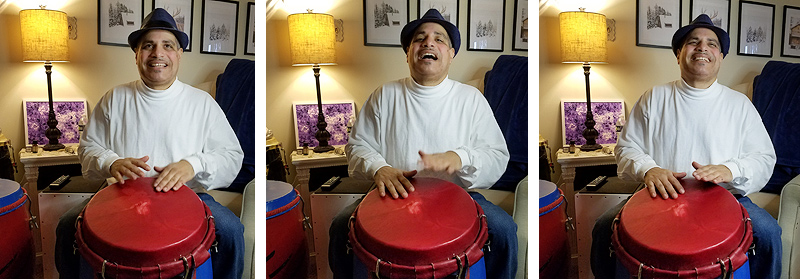
photos by Amy Skillman
Get in touch with Pedro at pantonetty333@gmail.com or (215) 255-5061.
Footnotes:
1. Images of Salinas, Puerto Rico, and sugar cane via Wikimedia Commons:
(a) Top left: Paella by flickr.com/people/yasmapaz, licensed under the Creative Commons Attribution-Share Alike 2.0 Generic license.
(b) Top center: Boats at rest by Eugenio Martínez Rodríguez, licensed under the Creative Commons Attribution-Share Alike 2.5 Generic license.
(c) Top right: Cordillera Central by Deb Stgo, licensed under the Creative Commons Attribution-Share Alike 2.0 Generic license. Color balance adjusted.
(d) Bottom left: Sugar cane by Marc Ryckaert, licensed under the Creative Commons Attribution-Share Alike 3.0 Unported license.
(e) Bottom right: Burning off sugar cane fields by Peter Forster, licensed under the Creative Commons Attribution-Share Alike 2.0 Generic license.
2. Image of Bomba band via Wikimedia Commons:
Bomba, Bomba by Yolydia, licensed under the Creative Commons Attribution-Share Alike 3.0 Unported license.



Brand icons for Facebook, YouTube, Instagram and other social media platforms are the trademark of their respective owners. No endorsement is implied.